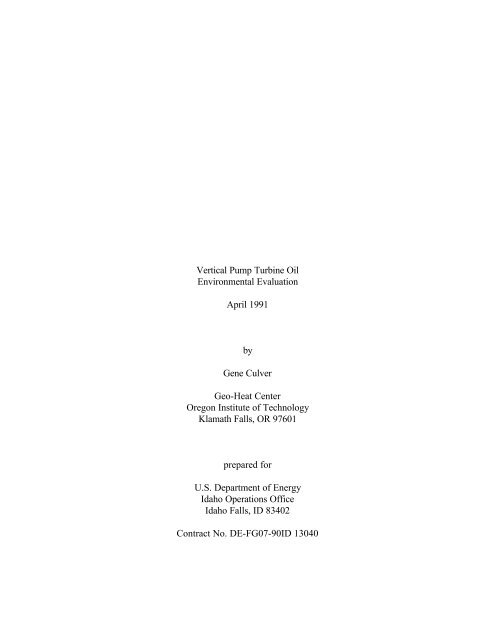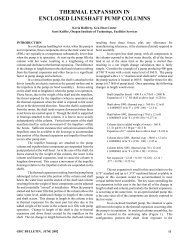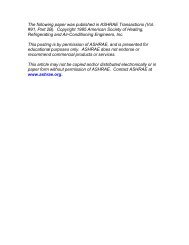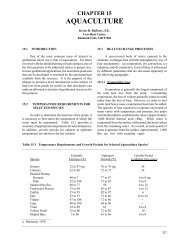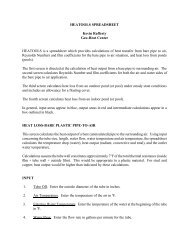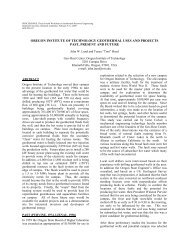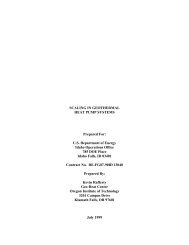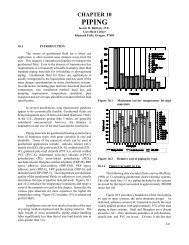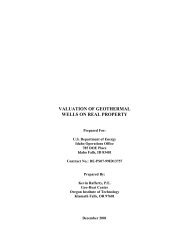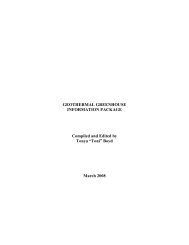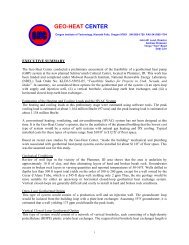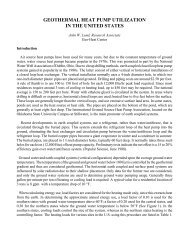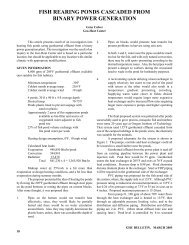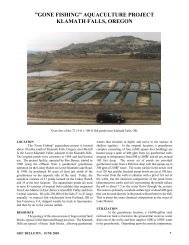Vertical Pump Turbine Oil Environmental Evaluation - Geo-Heat ...
Vertical Pump Turbine Oil Environmental Evaluation - Geo-Heat ...
Vertical Pump Turbine Oil Environmental Evaluation - Geo-Heat ...
You also want an ePaper? Increase the reach of your titles
YUMPU automatically turns print PDFs into web optimized ePapers that Google loves.
<strong>Vertical</strong> <strong>Pump</strong> <strong>Turbine</strong> <strong>Oil</strong><br />
<strong>Environmental</strong> <strong>Evaluation</strong><br />
April 1991<br />
by<br />
Gene Culver<br />
<strong>Geo</strong>-<strong>Heat</strong> Center<br />
Oregon Institute of Technology<br />
Klamath Falls, OR 97601<br />
prepared for<br />
U.S. Department of Energy<br />
Idaho Operations Office<br />
Idaho Falls, ID 83402<br />
Contract No. DE-FG07-90ID 13040
DISCLAIMER<br />
This material was prepared with the support of the U.S. Department of Energy (DOE Grant No. DE-<br />
FG07-90ID 13040). However, any opinions, findings, conclusions, or recommendations expressed<br />
herein are those of the author(s) and do not necessarily reflect the view of DOE."
Problem Statement<br />
VERTICAL PUMP TURBINE OIL ENVIRONMENTAL EVALUATION<br />
In Oregon low-temperature geothermal (defined as less than 250 o F) injection well construction, siting<br />
and receiving formations requires approval by the Water Resources Department (OWRD). In<br />
addition, the Oregon Department of <strong>Environmental</strong> Quality (ODEQ) has regulations concerning<br />
injection. It reviews proposed injection plans to assure that there will be no contamination of<br />
underground drinking water as defined by the U.S. <strong>Environmental</strong> Protection Agency (USEPA).<br />
A Klamath Falls city ordinance prohibits surface disposal of geothermal fluids after July 1, 1990, and<br />
as a result, a considerable number of injection wells needed to be drilled. In order to facilitate the<br />
well planning and approval process, representatives of both OWRD and ODEQ regularly visited<br />
Klamath Falls for several months before the July 1 deadline.<br />
Conversations with the OWRD and ODEQ representatives indicated they were very concerned about<br />
the potential for contamination of the geothermal (and cooler but hydraulically connected) aquifers<br />
by oils and grease. Their primary concern was over the practice of putting paraffin, motor oils and<br />
other hydrocarbons in downhole heat exchanger (DHE) wells to prevent corrosion. They also<br />
expressed considerable concern about the use of oil in production well pumps since the fluids pumped<br />
would be injected. Oregon (and Idaho) prohibit the use of oil-lubricated pumps for public water<br />
supplies except in certain situations where non-toxic food-grade lubricants are used. Although most<br />
geothermal systems would not usually be classed as a public water supply, sometimes the fluids are<br />
used for domestic hot water. Most direct use aquifers contain less than 10,000 ppm TDS and<br />
therefore, meet USEPA classification as drinking water aquifers (Safe Drinking Water Act, 1974).<br />
Since enclosed-lineshaft oil-lubricated pumps are the mainstay of direct-use pumping equipment, the<br />
potential for restricting their use became a concern to the <strong>Geo</strong>-<strong>Heat</strong> Center staff. An investigation<br />
into alternative pump lubrication schemes and development of rebuttals to potential restrictions was<br />
proposed and approved as a contract task.<br />
Background<br />
The enclosed-lineshaft oil-lubricated vertical turbine pump has the best service record in pumping<br />
geothermal fluids. This type of pump is used almost universally in direct use systems that employ well<br />
pumps. There are about 15 of these in use in Klamath Falls. The oil used in these pumps is generally<br />
known as "turbine oil." It is a petroleum-based oil and may contain certain proprietary additives<br />
for lubrication enhancement, anti-foaming, anti-rust, etc. In general, the turbine oils have a USDA<br />
classification of H-2 which means there must be no contact with food (USFDA - 21 CFR<br />
178.3620B).<br />
In an oil-lubricated turbine pump, the oil is introduced at the top of the pump column at a rate of<br />
several drops per minute. It flows down inside the shaft enclosing tube lubricating successively lower
earings and exits to the annular space between the column and well casing. The oil outlet is near<br />
the bottom of the pump column just above the pump itself. Over a year's time, the amount of oil used<br />
in a typical direct use pump is between 30 and 50 gallons. Ultimately, the accumulation of oil in the<br />
annulus may increase to the point where it displaces most of the water in the annulus and some oil<br />
is pumped--as much as is introduced or a few drops per 300-500 gallons. If for some reason the<br />
pumping water level lowers to the point where the pump would break suction, it could pump a<br />
considerable amount of oil for a short time.<br />
There are about 500 geothermal wells in Klamath Falls with downhole heat exchangers (DHEs).<br />
About the only problem experienced by most well owners is corrosion of the DHE pipes at the airwater<br />
interface. For many years, paraffin has been put down wells in an attempt to reduce the<br />
corrosion rate. In a few cases, other materials have been used--such as motor oil, grease and<br />
reportedly even used motor oil. This has been a significant concern of OWRD for sometime,<br />
especially the motor oil and grease. This practice is prohibited by state and federal laws. Since, in<br />
a DHE well, no geothermal water is removed and most wells have two DHEs--one for space heat and<br />
one for domestic water, the use of a thief sampler is difficult if not impossible. Therefore while there<br />
had been concern, no actions were taken except the occasional writing of letters and memorandums<br />
expressing the concern.<br />
Starting in spring of 1990, OWRD and ODEQ began taking samples from pumped wells and<br />
analyzing the samples for oils and grease. All new injection wells were required to have pump tests.<br />
Water samples are analyzed for oils and grease, and key geothermal chemical species to determine<br />
injection compatibility. In addition, a letter was sent to each well owner concerning the placement<br />
of foreign materials into wells and warning that anyone doing so would be held liable for clean-up<br />
costs--which could be very substantial.<br />
Because of the increased concerns and activities relating to possible oil contamination on the part of<br />
OWRD and ODEQ and the potential for banning use of turbine oils in geothermal production well<br />
pumps, a project was initiated to evaluate the problem and seek solutions. The project had three main<br />
objectives. These were:<br />
1. Obtain information about the currently used oils and evaluate the potential for health hazards.<br />
2. Determine what concerns there were in other states agencies.<br />
3. Find suitable substitutes for the currently used products in case of a ban on their use.<br />
Objective 1 - Obtain information and evaluate health hazards.<br />
Basic health and safety data for petroleum products is very easy to obtain. Every distributor has<br />
materials safety data sheets. Several examples are included in the Appendix. These include both oils<br />
which are and oils which are not FDA and USDA approved for incidental contact with food. Note<br />
that despite the fact that some are approved and some are not, the first-aid procedures and health<br />
hazards for oral ingestion (swallowing) are quite similar.
The Unocal and Chevron oils are all petroleum hydrocarbon based and all have the same percentage<br />
(99%) of paraffins--the difference is the additives that make up the remaining 1%. Some are USDA<br />
and FDA approved for incidental contact, others are not. Telephone discussions with Unocal<br />
lubrication laboratory scientists revealed that some of the non-approved oils may contain organometallics<br />
that are not approved. These additives increase the oiliness or lubrication properties, and<br />
the approved oils are not as good a lubricant in most applications.<br />
The oils used in turbine pumps appear to have very low toxicity particularly in the amount likely to<br />
be ingested. These oils are in fact approved for and being used in municipal water supply wells in<br />
California and Nevada.<br />
Objective 2 - Determine what concerns there were in other states agencies.<br />
As noted above, it was learned that oil-lubricated turbine pumps are used in municipal water supply<br />
wells in California and Nevada, and that the oil is turbine oil. Oregon and Idaho do not permit the<br />
use of oil-lubricated pumps except in exceptional cases where water-lubricated pumps will not<br />
operate and then only when FDA approved oils are used.<br />
Telephone conversations with health department engineers in both California and Nevada indicated<br />
that there are more oil-lubricated pumps than water-lubricated pumps used in municipal supply wells,<br />
and that most are lubricated with turbine oil which does not have the USDA H-1 classification.<br />
In both states, health department engineers are recommending switching from oil-lubricated to waterlubricated<br />
if possible and if not to use H-1 oil. Concern is not for health reasons since the amount<br />
carried over in normal operation is so small. The concern is that due to drought conditions, well<br />
water levels will be drawn down to the point where the pumps break water suction and start pumping<br />
larger amounts of the oil that has accumulated in the annulus. Even then, concern is not for health<br />
reasons as much as cosmetic ones.<br />
People, of course, don't like oily water and a very small amount causes complaints about appearance<br />
and odor. There have been several cases of oil pumping in California and once oil gets in a municipal<br />
system it persists as a film in piping which very slowly dissipates. Cleaning is difficult and expensive.<br />
The reason for switching to H-1 oil is that if it does get in a system they can at least say it is FDA<br />
approved.<br />
The potential for oil contamination of direct-use geothermal injection has not been addressed in<br />
California or Nevada. Although injection is into water classed as potential drinking water by USEPA,<br />
i.e., less than 10,000 ppm TDS, the accepting aquifers are not used for domestic water supplies.<br />
Utah, New Mexico and Arizona have not been concerned about low-temperature geothermal<br />
injection. Replies to telephone inquires were essentially the same: 1) there is very little injection<br />
taking place, so it was not considered a problem, and 2) where injection is or was likely to occur, it<br />
would be into aquifers not used for drinking water.
It appears that, at the present time at least, Oregon is the only place where concerns have been<br />
voiced.<br />
Legally, any oil--petroleum-based or synthetic including H-1 approved oils--is considered a<br />
contaminant if discharged on the soil, into surface water or into any USEPA classed underground<br />
source of drinking water. These include all aquifers with less than 10,000 ppm total dissolved solids.<br />
Not all manufacturers of turbine oils were contacted; but, it is believed that in general turbine oils do<br />
not contain materials in USEPA's Priority Toxic Pollutants list. EPA, therefore, is not terribly<br />
concerned about using these oils in the normal amount. Abnormal amounts or a spill would be a<br />
concern.<br />
Some of the oils currently reported to be in use, the industrial oils and some hydraulic oils may<br />
contain zinc di alkyl di phio phosphate. Zinc is on EPA priority list; therefore, oils would be less<br />
desirable than the turbine oils which do not contain this metalorganic.<br />
Objective 3 - Find suitable substitutes for currently used products in case of a ban on their use.<br />
Bearing loads should be relatively low in a turbine pump installed in a straight well and not run at a<br />
critical shaft speed. The extreme pressure and anti-friction additives required for point or line contact<br />
bearings are probably of little value--especially since there is a continually replenished supply of oil.<br />
In most situations, the turbine oils which do not contain the zinc metalorganic compounds should<br />
perform satisfactorily and be "tolerable" by OSEPA and state environmental quality agencies.<br />
Most major oil companies manufacture white mineral oils that have H-1 approval. They are available<br />
with viscosities the same as turbine oils and in journal bearings should have similar lubricating<br />
properties. These oils are about twice as expensive as turbine oils, and at least locally, are in short<br />
supply. They are used as a remedy for bloat in cattle and veterinarians report difficulty in obtaining<br />
supplies in large (55 gallon drums) containers.<br />
In addition to the turbine oils and petroleum-based, food-grade, H-1 oils, there are synthetic oils that<br />
have H-1 approval. Centrilift Hughes uses these oils in their submersible pumps. CL-5 which is a<br />
synthetic polyalpholefin has been in service in at least one geothermal pump for two years at a<br />
downhole temperature of 234 o F. CL-5 is expensive--$27.30 per gallon compared to turbine oils at<br />
about $3.30 per gallon.<br />
Conclusions<br />
Strict interpretation of codes would prohibit use of oil-lubricated turbine pumps in most, if not all,<br />
direct use applications and in irrigation and municipal water supply wells. As a practical matter, the<br />
use is tolerated since the amount of oil carried over into the produced water is very small and does<br />
not contain chemicals that are a serious concern.
There are some lubricants reportedly in use that contain metalorganic additives. <strong>Environmental</strong>ly,<br />
these are less desirable than other lubricants which do not. Lubricants which do not contain the<br />
additives should prove adequate in most applications.<br />
The concern in Oregon over oils used in turbine pumps appears to have been related to other<br />
materials used locally in Klamath Falls in downhole heat exchanger wells. Education of owners of<br />
downhole heat exchanger wells concerning the use of those materials, and of the concerned officials<br />
about the health hazards of turbine oil seems to have alleviated concerns. A contributing factor is that<br />
continuing testing has not detected any oils or grease in the aquifer.
APPENDIX<br />
Materials Safety Data Sheets<br />
for Lubricating <strong>Oil</strong>s
CHEVRON FM Lubricating <strong>Oil</strong> 32X Page 2 of 6<br />
2. FIRST AID<br />
EYE CONTACT:<br />
No first aid procedures are required. However, as a precaution flush eyes<br />
with fresh water for 15 minutes. Remove contact lenses if worn.<br />
SKIN CONTACT:<br />
No first aid procedures are required. As a precaution, wash skin<br />
thoroughly with soap and water. Remove and wash contaminated clothing.<br />
INHALATION:<br />
Since this material is not expected to be an immediate inhalation problem,<br />
no first aid procedures are required.<br />
INGESTION:<br />
If swallowed, give water or milk to drink and telephone for medical<br />
advice. Consult medical personnel before inducing vomiting. If medical<br />
advice cannot be obtained, then take the person and product container to<br />
the nearest medical emergency treatment center or hospital.<br />
3. IMMEDIATE HEALTH EFRECTS<br />
EYE CONTACT:<br />
This substance is not expected to cause prolonged or significant eye<br />
irritation. This hazard evaluation is based on the data from similar<br />
materials.<br />
SKIN IRRITATION:<br />
This substance is not expected to cause prolonged or significant skin<br />
irritation. This hazard evaluation is based on data from similar<br />
materials.<br />
DERMAL TOXICITY:<br />
The systemic toxicity of this substance has not been determined. However ,<br />
it should be pract i cally non-toxic to internal organs if it gets on the<br />
skin. This hazard evaluation is based on data from similar materials.<br />
RESPIRATORY/INHALATION:<br />
The systemic toxicity of this substance has not been determined.<br />
it should be practically non-toxic to internal organs if inhaled.<br />
hazard evaluation is based on data from similar materials.<br />
INGESTION:<br />
However ,<br />
This<br />
The systemic toxicity of this substance has not been determined. However,<br />
it should be practically non-toxic to internal organs if swallowed. This<br />
hazard evaluation is based on data from similar materials.<br />
4. PROTECTIVE EQUIPMENT<br />
EYE PROTECTION:<br />
No special eye protection is usually necessary.<br />
SKIN PROTECTION:<br />
No special skin protection is usually necessary. Avoid prolonged or<br />
frequently repeated skin contact with this material. Skin contact can be<br />
Revision Number: 5 Revision Date: 07/30/89 MSDS Number: 000842<br />
NDA - No Data Available NA - Not Applicable<br />
x-o 21 (1- )
CHEVRON FM Lubricating <strong>Oil</strong> 32X<br />
Page 3 of 6<br />
minimized by wearing protective clothing.<br />
RESPIRATORY PROTECTION:<br />
No special respiratory protection is normally required. However, if<br />
operating conditions create high airborne concentrations, the use of an<br />
approved respirator is recommended.<br />
VENTILATION:<br />
Use adequate ventilation to keep the airborne concentrations of this<br />
material below the recommended exposure standard.<br />
5. FIRE PROTECTION<br />
FLASH POINT: (COC) 356F (18GC) (Min.)<br />
AUTO IGNITION: NDA<br />
FLAMMABILITY: NA<br />
EXTINGUISHING MEDIA:<br />
C02, Dry Chemical, Foam, Water Fog<br />
NFPA RATINGS: Health 0; Flammability 1; Reactivity 0; Special NDA;<br />
HMIS RATINGS: Health 0; Flammability 1; Reactivity 0; Other NDA;<br />
(Least-O, Slight-I, Moderate-2, High-3, Extreme-4). These values are<br />
obtained using the guideline£or published evaluations prepared by the<br />
National Fire Protection Association or, if applicable, the National<br />
Paint and Coating Association, and do not necessarily reflect the hazard<br />
evaluation of the Chevron <strong>Environmental</strong> Health Center. Read the entire<br />
document and label before using this product.<br />
FIRE FIGHTING PROCEDURES:<br />
For fires involving this material, do not enter any enclosed or confined<br />
fire space without proper protective equipment, including self-contained<br />
breathing apparatus.<br />
COMBUSTION PRODUCTS:<br />
Normal combustion forms carbon dioxide and water vapor; incomplete<br />
combustion can produce carbon monoxide. Incomplete combustion can produce<br />
carbon monoxide.<br />
6. STORAGE, HANDLING, AND REACTIVITY<br />
HAZARDOUS DECOMPOSITION PRODUCTS:<br />
NDA<br />
STABILITY:<br />
Stable.<br />
HAZARDOUS POLYMERIZATION:<br />
Polymerization will not occur.<br />
INCOMPATIBILITY:<br />
May react with strong oxidizing agents, such as chlorates, nitrates,<br />
peroxides, etc.<br />
SPECIAL PRECAUTIONS:<br />
DO NOT weld, heat or drill container. Residue may ignite with explosive<br />
violence i f heated sufficiently. CAUTION! Do not use pressure to empty<br />
drum or explosion may result.<br />
Revision Number: 5 Revision Date: 07/30/89 MSDS Number: 000842<br />
NDA - No Data Available NA - Not Applicable<br />
X -00S021 (01-89)
Emergency Phone Number(800) 457-2022<br />
Material Safety Data Sheet<br />
CHEVRON GST <strong>Oil</strong> 32<br />
CLOUGH OIL COMPANY<br />
POBOX 338<br />
KLAMATH FALLS, OR 97601<br />
Print Date: November 21, 1989<br />
MATERIAL ORDERED FOR:<br />
PACKAGE PICK-UP WILLBRDG<br />
PORTLAND, OR 97210<br />
This Material Safety Data Sheet contains environmental, health and<br />
toxicology information for your employees. Please make sure this<br />
information is given to them. It also contains information to help<br />
you meet community right-to-know/emergency response reporting<br />
requirements under SARA Title III and many other laws. If you resell<br />
this product, this MSDS must be given to the buyer or the information<br />
incorporated in your MSDS. Discard any previous edition of this MSDS.<br />
Update viscosity.<br />
1. PRODUCT IDENTIFICATION<br />
CHEVRON GST <strong>Oil</strong> 32<br />
- A HAZARD WARNING IS NOT REQUIRED FOR THIS PRODUCT UNDER<br />
OSHA HAZARD COMMUNICATION STANDARD (29 CFR 1910.1200)<br />
CHEVRON PRODUCT NUMBER(S): CPS234229<br />
PRODUCT INFORMATION: (800)582-3835<br />
CPS234229<br />
Page 1 of 6<br />
Revision Number: 10 Revision Date: 10/24/89 MSDS Number: 000221<br />
NDA - No Data Available NA - Not Applicable<br />
prepared According to the OSHA Hazard communication<br />
Standard (29 CFR 1910 . 1200) by the Chevron <strong>Environmental</strong><br />
Health center, Inc., P.O. Box 4054, Richmond, CA 94804.<br />
.=:c<br />
Chevron<br />
X-OOS051 (06-89)<br />
••
CHEVRON GST <strong>Oil</strong> 32 Page 2 of 6<br />
2. FIRST AID<br />
EYE CONTACT:<br />
No first aid procedures are required. However, as a precaution flush eyes<br />
with fresh water for 15 minutes. Remove contact lenses if worn.<br />
SKIN CONTACT:<br />
No first aid procedures are required. As a precaution, wash skin<br />
thoroughly with soap and water. Remove and wash contaminated clothing.<br />
INHALATION:<br />
Since this material is not expected to be an immediate inhalation problem,<br />
no first aid procedures are required. I<br />
INGESTION:<br />
If swallowed, give water or milk to drink and telephone for medical<br />
advice. Consult medical personnel before inducing vomiting. If medical<br />
advice cannot be obtained, then take the person and product container to<br />
the nearest medical emergency treatment center or hospital.<br />
3. IMMEDIATE HEALTH EFFECTS<br />
EYE CONTACT:<br />
This substance is not expected to cause prolonged or significant eye<br />
irritation. This hazard evaluation is based on the data from similar<br />
materials .<br />
SKIN IRRITATION:<br />
This substance is not expected to cause prolonged or significant skin<br />
irritation. This hazard evaluation is based on data from similar<br />
mater ials. ,<br />
DERMAL TOXICITY:<br />
If absorbed through the skin,<br />
non-toxic to internal organs.<br />
from similar materials.<br />
RESPIRATORY/INHALATION:<br />
this substance is considered practically<br />
This hazard evaluation is based on data<br />
If inhaled, this substance is considered practically non-toxic to internal<br />
organs. This hazard evaluation is based on data from similar materials.<br />
INGESTION:<br />
If swallowed, this substance is considered practically non-toxic to<br />
internal organs. This hazard evaluation is based on data from similar<br />
materials.<br />
4. PROTECTIVE EQUIPMENT<br />
EYE PROTECTION:<br />
No special eye protection is usually necessary.<br />
SKIN PROTECTION:<br />
No special skin protection is usually necessary. Avoid prolonged or<br />
frequently repeated skin contact with this material. Skin contact can be<br />
minimized by wearing protective clothing.<br />
Revision Number: 10 Revision Date: 10/24/89 MSDS Number: 000221<br />
NDA - No Data Available NA - Not Applicable<br />
X-OOS021 (01-89)
CHEVRON GST <strong>Oil</strong> 32 Page<br />
RESPIRATORY PROTECTION:<br />
No special respiratory protection is normally required. However, if<br />
operating conditions create airborne concentrations which exceed the<br />
recommended exposure standards, the use of an approved respirator is<br />
required.<br />
VENTILATION:<br />
Use adequate ventilation to keep the airborne concentrations of this<br />
material below the recommended exposure standard.<br />
5. FIRE PROTECTION<br />
FLASH POINT: (COC) 374F (190C) Min.<br />
AUTOIGNITION: NDA<br />
FLAMMABILITY: NA<br />
EXTINGUISHING MEDIA:<br />
C02, dry chemical, foam and water fog.<br />
NFPA RATINGS: Health 0; Flammability 1; Reactivity 0; Special NDA;<br />
3 of 6<br />
HMIS RATINGS: Health 0; Flammability 1; Reactivity 0; Other NDA;<br />
(Least-G, Slight-I, Moderate-2, High-3, Extreme-4). These values are<br />
obtained using the guidelines or published evaluations prepared by the<br />
National Fire Protection Association or, if applicable, the National<br />
Paint and Coating Association, and do not necessarily reflect the hazard<br />
evaluation of the Chevron <strong>Environmental</strong> Health Center. Read the entire<br />
document and label before using this product.<br />
FIRE FIGHTING PROCEDURES:<br />
For fires involving this material, do not enter any enclosed or confined<br />
fire space without proper protective equipment, including self-contained<br />
breathing apparatus.<br />
COMBUSTION PRODUCTS:<br />
Normal combustion forms carbon dioxide and water vapor; incomplete<br />
combustion can produce carbon monoxide.<br />
6. STORAGE, HANDLING, AND REACTIVITY<br />
HAZARDOUS DECOMPOSITION PRODUCTS:<br />
NDA<br />
STABILITY:<br />
Stable.<br />
HAZARDOUS POLYMERIZATION:<br />
Polymerization will not occur.<br />
INCOMPATIBILITY:<br />
May react with strong oxidizing agents, such as chlorates, nitrates,<br />
peroxides, etc.<br />
SPECIAL PRECAUTIONS:<br />
DO NOT weld, heat or drill container. Residue may ignite with explosive<br />
violence if heated sufficiently.<br />
CAUTION! Do not use pressure to empty drum or explosion may result.<br />
Revision Number: 10 Revision Date: 10/24/89 MSDS Number: 000221<br />
NDA - No Data Available NA - Not Applicable<br />
....<br />
X-OOS021 (01-891
CHEVRON GST <strong>Oil</strong> 32 Page<br />
7. PHYSICAL PROPERTIES<br />
SOLUBILITY: Soluble in hydrocarbon solvents; insoluble in water.<br />
APPEARANCE: Yellow liquid.<br />
BOILING POINT: NDA<br />
MELTING POINT: NA<br />
EVAPORATION: NA<br />
SPECIFIC GRAVITY: 0.87 @ lS.6/1S.6C<br />
VAPOR PRESSURE: NA<br />
PERCENT VOLATILE (VOLUME %): NA<br />
VAPOR DENSITY (AIR=l): NA<br />
VISCOSITY: 32.0 cSt @ 40C (Min.)<br />
8. SPILL RESPONSE AND DISPOSAL<br />
4 of 6<br />
CHEMTREC EMERGENCY PHONE NUMBER: (800) 424-9300 (24 hour).<br />
SPILL/LEAK PRECAUTIONS:<br />
This material is not expected to present any environmental problems other<br />
than those associated with oi1 spills.<br />
Stop the source of the leak or release. Clean up releases as soon as<br />
possible. Contain liquid to prevent further contamination of soil,<br />
surface water or groundwater. Clean up small spills using appropriate<br />
techniques such as sorbent materials or pumping. Where feasible and<br />
appropriate, remove contaminated soil. Follow prescribed procedures for<br />
reporting and responding to larger releases.<br />
DISPOSAL METHODS:<br />
Place contaminated materials in disposable containers and dispose of in a<br />
manner consistent with applicable regulations. Contact local<br />
environmental or health authorities for approved disposal of this<br />
material.<br />
9. EXPOSURE STANDARDS, REGULATORY LIMITS AND COMPOSITION<br />
COMPOSITION COMMENT:<br />
All the components of this material are on the Toxic Substances Control<br />
Act Chemical Substances Inventory.<br />
This substance is subject to the provisions of the Pennsylvania Worker and<br />
Community Right-to-Know Act. Specific chemical identities are trade secret<br />
under the provisions of 35 Pennsylvania Statute Section 7311.<br />
Based upon information reviewed to date, this product fits the ACGIH<br />
definition for mineral oil mist. The ACGIH TLV is Smg/m3, the OSHA PEL is<br />
5mg/m3.<br />
The percent compositions are given to allow for the various ranges of<br />
Revision Number: 10 Revision Date: 10/24/89 MSDS Number: 000221<br />
NDA - No Data Available NA - Not Applicable<br />
X -DOS021 (01- 89l
CHEVRON GST <strong>Oil</strong> 32 Page 6 of 6<br />
11. PRODUCT TOXICOLOGY DATA<br />
EYE IRRITATION:<br />
NDA. The hazard evaluation was based on data from similar materials.<br />
SKIN IRRITATION:<br />
NDA. The hazard evaluation was based on data from simi lar materials.<br />
DERMAL TOXICITY:<br />
NDA. The hazard evaluation was based on data from similar materials.<br />
RESPIRATORY/INHALATION:<br />
NDA. The hazard evaluation was based on data from similar materials.<br />
INGESTION:<br />
NDA. The hazard evaluation was based on data from similar materials.<br />
12. ADDITIONAL HEALTH DATA<br />
ADDITIONAL HEALTH DATA COMMENT:<br />
This product contains petroleum base oils which may be refined by various<br />
processes including severe solvent extraction, severe hydrocracking, or<br />
severe hydrotreating. None of the oils require a cancer warning under the<br />
OSHA Hazard Communication Standard (29 CFR 1910.1200). These oils have<br />
not been listed in the National Toxicology Program (NTP) Annual Report nor<br />
have they been classified by the International Agency for Research on<br />
Cancer (IARC) as; carcinogenic to humans (Group 1), probably carcinogenic<br />
to humans (Group 2A), or possibly carcinogenic to humans (Group 2B).<br />
This product contains petroleum base oils refined by a combination of<br />
severe hydrocracking and hydrotreating. The potential of paraffinic base<br />
oil prepared by this process to cause cancer has not been specifically<br />
addressed by the OSHA Hazard Communication Standard (29 CFR 1910.1200),<br />
the International Agency for Research on Cancer (IARC), nor the National<br />
Toxicology Program (NTP) Annual Report. However, the process conditions,<br />
chemical analyses, and the results of mutagenicity tests all support our<br />
opinion that this oil should not cause skin cancer.<br />
**********************************************************************<br />
The above information is based on the data of which we are aware and is<br />
believed to be correct as 6f the date hereof. Since the information<br />
contained herein may be applied under conditions beyond our control and<br />
with which we may be unfamiliar and since data made available subsequent<br />
to the date hereof may suggest modification of the information. we do not<br />
assume any responsibility for the results of its use .. This information is<br />
furnished upon condition that the person receiving it shall make his own<br />
determination of the suitability of the material for his particular<br />
purpose .<br />
Revision Number: 10 Revision Date: 10/24/89 MSDS Number: 000221<br />
NDA - No Data Available NA - Not Applicable<br />
X-OOS021 (01-B9)
I 2250 D00209<br />
r---------------- UNION OIL co.<br />
Product Name: UNOCAL UNAX AW 32<br />
Product Code No: 04641<br />
SECTION III - HEALTH HAZARDS/ROUTES OF ENTRY<br />
INGESTION (SWALLOWING):<br />
Page 3<br />
Issue Date: 06/01/90<br />
Statusl FINAL<br />
WHILE THIS MATERIAL HAS A LOW DEGREE OF TOXICITY, INGESTION OF EXCESSIVE QUANTITIES<br />
MAY CAUSE IRRITATION OF THE DIGESTIVE TRACT.<br />
COMMENTS:<br />
THIS MATERIAL HAS NOT BEEN IDENTIFIED AS A CARCINOGEN BY NTP, IARC OR OSHA.<br />
SECTION IV - SPECIAL PROTECTION INFORMATION<br />
VENTILATION:<br />
C IF CURRENT VENTILATION PRACTICES ARE NOT ADEQUATE TO MAINTAIN AIRBORNE CONCENTRATIONS<br />
BELOW THE ESTABLISHED EXPOSURE LIMITS (SEE SECTION I), ADDITIONAL VENTILATION OR<br />
EXHAUST SYSTEMS MAY BE REQUIRED. WHERE EXPLOSIVE MIXTURES MAY BE PRESENT, ELECTRICAL<br />
SYSTEMS SAFE FOR SUCH LOCATIONS MUST BE USED. .<br />
RESPIRATORV PROTECTION:<br />
THE USE OF RESPIRATORY PROTECTION IS ADVISED WHEN CONCENTRATIONS EXCEED THE<br />
ESTABLISHED EXPOSURE LIMITS (SEE SECTION I). DEPENDING ON THE AIRBORNE CONCENTRATION,<br />
USE A RESPIRATOR OR GAS MASK WITH APPROPRIATE CARTRIDGES AND CANNISTERS (NIOSH<br />
APPROVED, IF AVAILABLE) OR SUPPLIED AIR EQUIPMENT.<br />
PROTECTIVE GLOVES:<br />
THE USE OF GLOVES IMPERMEABLE TO THE SPECIFIC MATERIAL HANDLED IS ADVISED TO PREVENT<br />
SKIN CONTACT AND POSSIBLE IRRITATION.<br />
EVE PROTECTION:<br />
APPROVED EYE PROTECTION TO SAFEGUARD AGAINST POTENTIAL EYE CONTACT, IRRITATION OR<br />
INJURY IS RECOMMENDED.<br />
OTHER PROTECTIVE EQUIPMENT:<br />
IT IS SUGGESTED THAT A SOURCE OF CLEAN WATER BE AVAILABLE IN THE WORK AREA FOR<br />
FLUSHING EYES AND SKIN. IMPERVIOUS CLOTHING SHOULD BE WORN AS NEEDED.<br />
SECTION V - REACTIVITY DATA<br />
REACTIVITV:<br />
STABLE UNDER NORMAL CONDITIONS OF STORAGE AND HANDLING.<br />
CONDITIONS AFFECTING REACTIVITY:<br />
EXTENDED EXPOSURE TO HIGH TEMPERATURES MAY CAUSE DECOMPOSITION.<br />
INCOMPATIBLE MATERIALS:<br />
AVOID CONTACT WITH STRONG OXIDIZING AGENTS.<br />
HAZARDOUS DECOMPOSITION PRODUCTS:<br />
COMBUSTION MAY YIELD MAJOR AMOUNTS OF OXIDES OF CARBON AND MINOR AMOUNTS OF OXIDES OF<br />
SULFUR AND NITROGEN.<br />
HAZARDOUS POLYMERIZATION:<br />
WILL NOT OCCUR
Product Name: UNOCAL TURBINE OIL 32<br />
Product Code No: 04621<br />
Responsible Party:<br />
UNOCAL REFINING & MARKETING DIVISION<br />
UNION OIL COMPANY OF CALIFORNIA<br />
1201 WEST 5TH STREET<br />
LOS ANGELES, CALIFORNIA 90017<br />
CCN¥ACT FOR FURTHER INFORMATION:<br />
MSDS COORDINATOR 213-977-7589<br />
PRODUCT IDENTIFICATION<br />
PRODUCT NAME: UNOCAL TURBINE OIL 32<br />
SYNONYMS: UNION TURBINE OIL 32<br />
GENERIC NAME: INDUSTRIAL 0 IL<br />
CHEMICAL FAMILY: PETROLEUM HYDROCARBOU<br />
DOT PROPER<br />
SHIPPING NAME: NOT APPLICABLE<br />
ID NUMBER: NONE<br />
DOT HAZARD<br />
CLASSIFICATION: NOT REGULATED<br />
PRECAUTIONARY WARNING<br />
MATERIAL SAFETY DATA SHEET<br />
UNOCALfJ><br />
1201 West 5th Street<br />
Los Angeles, California 90017<br />
D01758<br />
Page 1<br />
Issue Date: 05125/90<br />
Status: FINAL<br />
Transportation Emergencies:<br />
CHEMTREC<br />
(800) 424-9300 Cont. U.S.<br />
(202) 483-7616 (Collect)<br />
from Alaska & Hawaii<br />
Health Emergencies:<br />
LOS ANGELES POISON<br />
CONTROL CENTER (24 hrs)<br />
(aOO) 356-3129<br />
DO NOT PRESSURIZE, CUT, WELD, BRAZE, SOLDER, GRIND OR DRILL ON OR NEAR CONTAINER OR<br />
EXPOSE TO ANY SOURCE OF IGNITION. "EMPTY" CONTAINER RETAINS RESIDUE (LIQUID ANDIOR<br />
VAPOR) AND MAY EXPLODE IN HEAT OF A FIRE.<br />
SECTION I - COMPONENTS PERCENT<br />
HAZARDOUS COMPONENTS<br />
SOLVENT DEWAXED DISTILLATE, HEAVY PARAFFIN<br />
CAS I: 64742-65-0 99<br />
OTHER COMPONENTS<br />
TRADE SECRET<br />
CAS I: PROPRIETARY 1<br />
EXPOSURE LIMIT UNITS AGENCY<br />
5.000<br />
10.000<br />
5.000<br />
5.000<br />
5.000<br />
mg/m3 ACGIH<br />
mg/m3 ACGIH<br />
mg/m3 MSHA<br />
mg/m3 OSHA<br />
mg/m3 CAL OSHA<br />
NOT ESTABLISHED<br />
TYPE<br />
TWA<br />
STEL<br />
TWA<br />
TWA<br />
TWA<br />
THIS PRODUCT CONTAINS THE FOLLOWING CHEHICALS SUBJECT TO THE REPORTING<br />
REQUIREMENTS OF SARA 313 AND 40 CFR 372: CAS NUMBER WEIGHT %<br />
--NONE--


